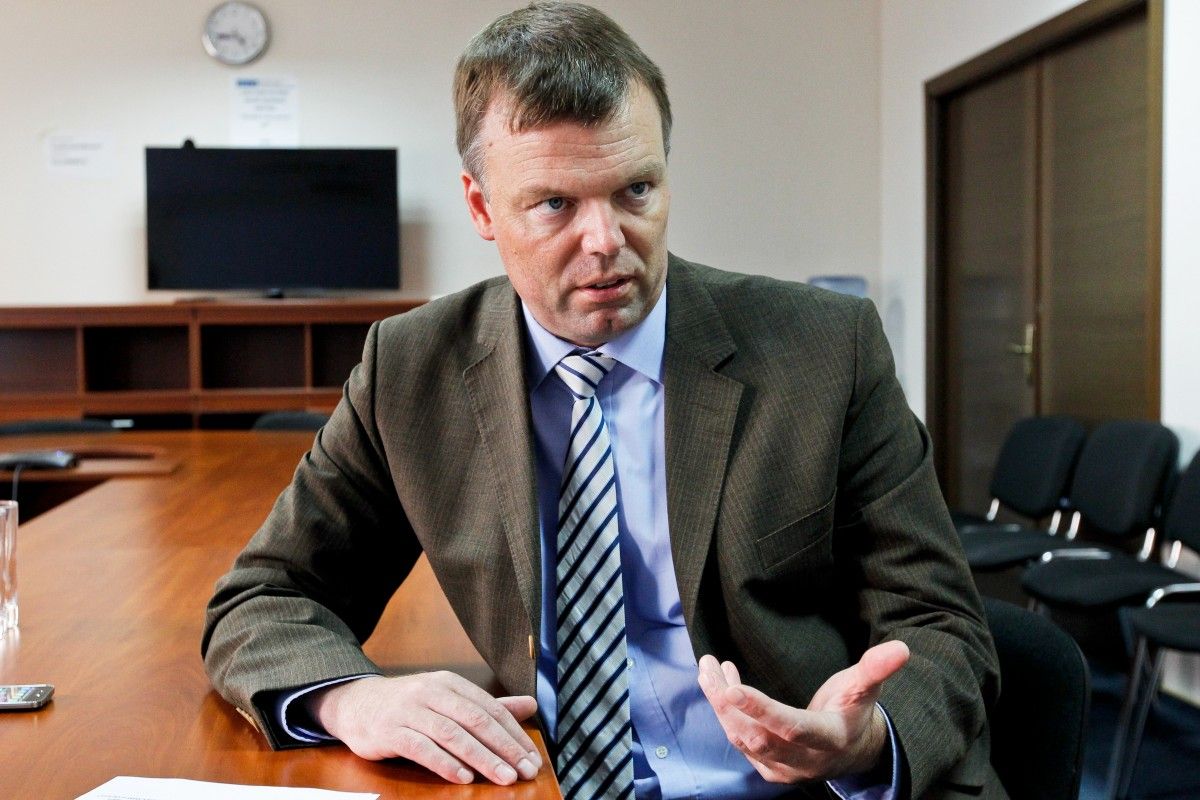 Alexander Hug, Principal Deputy Chief Monitor of the OSCE Special Monitoring Mission to Ukraine. Before this mission, Hug was a Section Head and a Senior Adviser to the OSCE High Commissioner on National Minorities. Hug, a trained lawyer, served as an officer in the Swiss Army, including a period as regional commander of the Swiss Headquarters Support Unit for the OSCE in northern Bosnia and Herzegovina. He has also worked for the OSCE Mission in Kosovo, the Temporary International Presence in Hebron, and the EU Rule of Law Mission in Kosovo (EULEX). Alexander Hug is not the Chief Monitor of the Mission to Ukraine, but while a Chief would work from an office, Hug is the most senior monitor actually on the ground, and while Chiefs come and go over the years, Hug has been in the field since the conflict began with the Maidan protests in Kiev. Photo: UNIAN
Alexander Hug, Principal Deputy Chief Monitor of the OSCE Special Monitoring Mission to Ukraine. Before this mission, Hug was a Section Head and a Senior Adviser to the OSCE High Commissioner on National Minorities. Hug, a trained lawyer, served as an officer in the Swiss Army, including a period as regional commander of the Swiss Headquarters Support Unit for the OSCE in northern Bosnia and Herzegovina. He has also worked for the OSCE Mission in Kosovo, the Temporary International Presence in Hebron, and the EU Rule of Law Mission in Kosovo (EULEX). Alexander Hug is not the Chief Monitor of the Mission to Ukraine, but while a Chief would work from an office, Hug is the most senior monitor actually on the ground, and while Chiefs come and go over the years, Hug has been in the field since the conflict began with the Maidan protests in Kiev. Photo: UNIAN
OSCE Monitor on Ukraine: Deadly violence has doubled since last year
Despite the Minsk Agreement, the hostilities have again escalated in Eastern Ukraine. Alexander Hug, who spent years in the field monitoring the situation, says although there are hundreds or thousand of violations of the ceasefire every day, without the Minsk Agreement it would have been even worse. But he does not see thousands of Russian soldiers, who should be there according to certain media outlets, although he can confirm the presence of foreigners fighting on both sides.
Published: August 15, 2017, 1:16 pm
While the international community insists on the implementation of the Minsk agreements, in the Donbass region and in Ukraine as a whole, it faces growing opposition. On one hand, it is clear that Kiev does not intend to provide self-governance to the two break away republics, the Donetsk and Luhansk Peoples Republics (DPR and LPR), as it was stated in the document, and on the other, the two republics do not want to return to Ukraine even if granted self-governance. According to polls, two thirds of their population is eager to join Russia, and the supporters of reintegration in Ukraine only constitute eleven percent.
The stalemate of the situation is expressed in the gradual escalation of hostilities along the 500-kilometres contact line, which periodically takes a toll on civilians, whose houses come under artillery fire. According to the OSCE Special Monitoring Mission, in the last reporting period dating from February 16 to July 16 this year, 45 people died in Donbass and 216 were injured, which is a 110 percent increase from the previous reporting period.
The work of the OSCE isn’t without risk either. On April 23, two of the monitors were killed when their car hit what is believed to have been a tank mine.
Free West Media decided to talk directly to one of the most experienced and informed experts on this issue: Alexander Hug, Principal Deputy Chief Monitor of the OSCE Special Monitoring Mission to Ukraine. We meet Alexander Hug in the centre of Donetsk, the capital of the DPR and the city in the heart of the conflict, not far away from the contact line. Hug has been working with the Mission in Ukraine since the very beginning of the conflict. He personally visits the forward positions of both sides, monitoring the implementation of the ceasefire and arms withdrawal agreements, communicating with both military people and civilians, listening to their testimonies and attending sites affected by shelling.
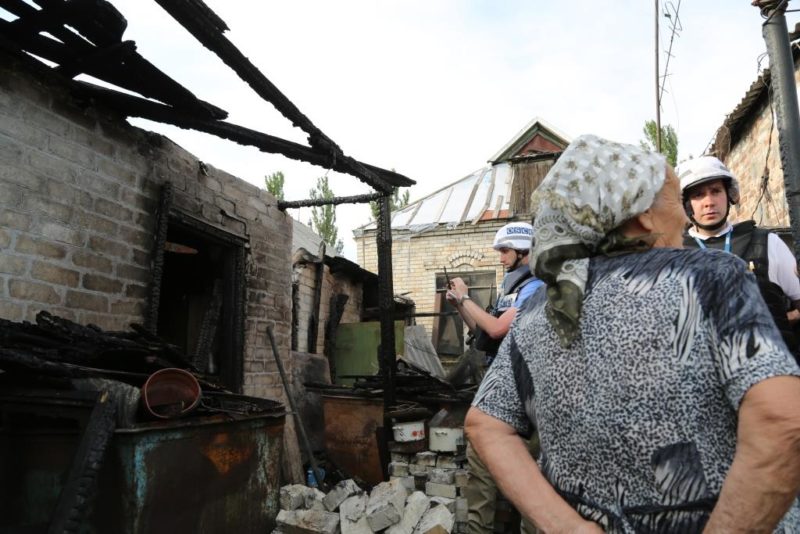
Civilian showing to OSCE monitors impact on her house by shelling in the Trudivske area of Donetsk City, July 20, 2017. Photo: OSCE / Mariia Aleksevych
Hug provides us with the latest death toll. Since the beginning of this year, there have been 281 civilian casualties: 51 killed, 230 injured. The causes were determined to be: From shelling 32 killed, 171 injured. From mines and unexploded ordinance 17 killed, 43 injured. From small arms fire 2 killed, 16 injured. Most of the casualties happen at the Donetsk part of the contact line, while Luhansk experience seven times less casualties.
The biggest loss of life and injuries are due to heavy weapons, exactly the weapons that should have been withdrawn long ago to a distance of at least 15 kilometres from the contact line, in accordance to the Minsk Agreement.
– The biggest part, 203 out of 281 of those civilian casualties, were caused by shrapnel. That is mortar, artillery including multiple launch rocket systems and tank fire. We still see these weapons on both sides of the contact line in areas where they shouldn’t be. Since the beginning of the year we’ve seen over 2 500 accumulated number of these types of weapons in areas where they shouldn’t be. Tanks very close to the contact line, artillery systems very close to the contact line.
Often, heavy weapons are placed in settlements like towns, which them selves then become targets, Hug explains.
– If the other side fires onto this tank or of this howitzer or this mortar, whatever it is, then it will unavoidably hit anything that is around, because in this conflict they are not using precision weapon, but as you know, a carpet use. In some of the areas we have towns on both sides, like Jasinovata and Avdeyevka.
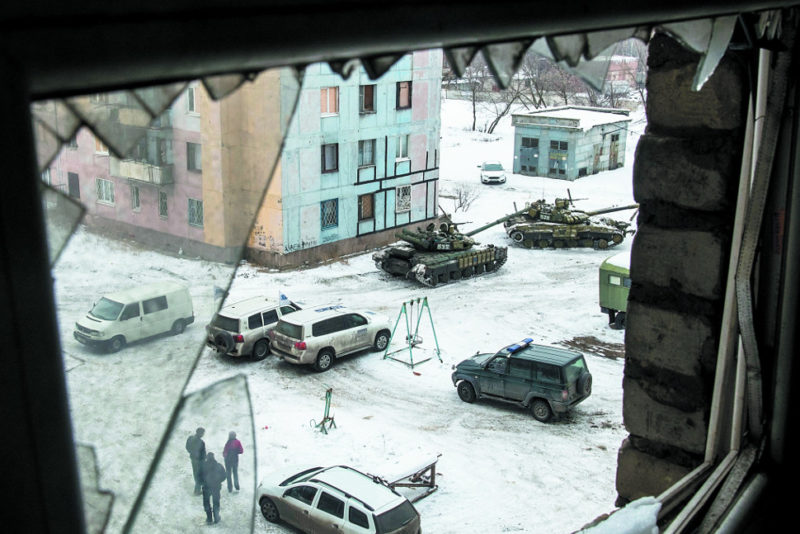
Ukrainian T-64 tanks near apartment buildings in Avdeyevka, close to the contact line and well inside the 15 kilometre forbidden zone. At least two vehicles belonging to the OSCE can be seen in this picture, as well as a black vehicle most likely belonging to Ukraine security forces. Photo: Evgueni Maloletka / TASS
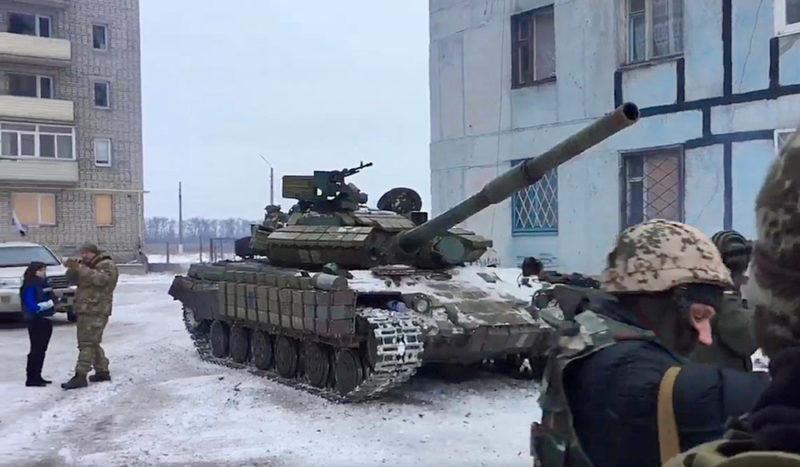
The same event was filmed by the journalist Tom Burridge. An OSCE monitor can be seen arguing with the Ukrainian officer.
The contact line goes right through settlements and no side wants to vacate their positions.
– In many places they have positions very close to one another, sometimes 10, 20 metres. They also need to go back. And the distance between infantry positions, not heavy weapons but infantry positions, need to be at least two kilometres in order to prevent the fighting.
The withdrawal would stop the immediate fighting, but still you would have casualties from mines, Hug says.
– Since September 2014, there is a clear responsibility to remove mines and not to lay down any new ones, but we see on both sides that they still use mines very openly. So, you see them – antitank mines, antipersonnel mines – on both sides of the contact line. But some you don’t see at all, because they are well-hidden, they are dug in, they are set of by tripwire or they are improvised explosive devices.
The Minsk Agreement is not fully respected at this moment, but Hug points out that some parts have in fact been implemented.
– We know that some weapons have been withdrawn because we see them in the back. And there is some sort of a verification regime on these weapons. We’ve also seen that the fighting had become very static to the contact line, it is just not as fluid as it was in 2014. So it would be incorrect to say that Minsk is not implemented. It is partially only implemented and very invariably implemented.
Minsk is also not just the measures themselves, it is also a platform where everybody meets and discusses, which is also very important, Hug stresses, even if it doesn’t translate into immediate action.
– There are connections, communication channels that allow to control the escalation. Without that, it would be very difficult and I cannot speculate what the situation in Donetsk or elsewhere would look like if it would not be for the Minsk agreements.
According to Hug, both sides could stop hostilities along the 500-kilometres line tomorrow, if they only wanted.
– You have days with thousands of violations and than you have days with hundreds. It fluctuates. But as long as the sides are as close as they are now and as long as heavy weapons have not been withdrawn, this will continue to be the case, it will not end. And all we and other international organisations do is treating the symptoms. We try to repair infrastructure or help to facilitate localised ceasefires. We assist or facilitate delivery of humanitarian aid, we assist to bring out the dead and the injured, we try to facilitate easier passage of the contact line, but all of that is symptom treatment.
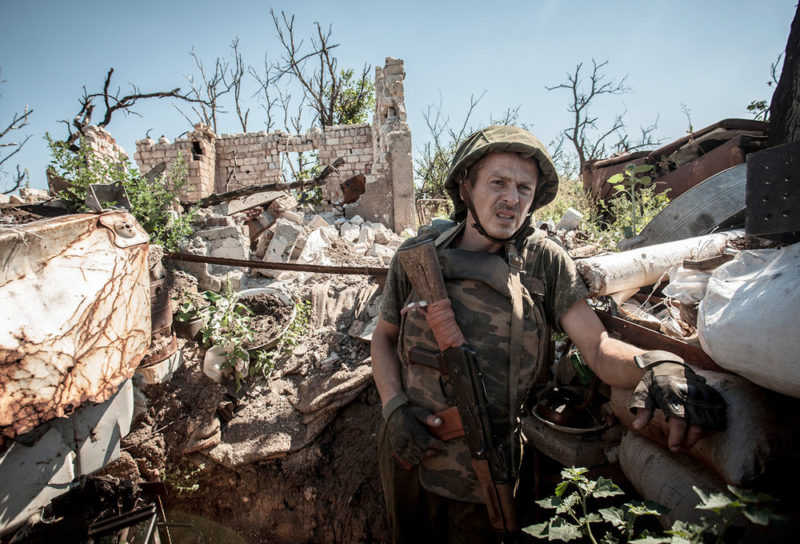
A commander tells his story in a position closest to the Conflict line near the industrial zone of Avdeyevka DPR, august 2017. Photo: Sergey Belous / Free West Media
Hug is certain that the presence of the OSCE has a deterrence effect, but he doesn’t want to speculate on the exact impact of the Monitoring Mission. The monitors cannot interfere, they have no judicial power, but both sides know the will report what they see.
– We will not speculate, we will make no assumptions. We only provide what we see, what we hear, what we are able to triangulate. Knowing this we are certain that our presence helps to defuse tense situations, be it at the contact line or be it any demonstrations which we often visit, not just here in the east but in any of the towns where they would occur. For instance, we have a team in Odessa where we also facilitate dialogue between these pro and anti Maidan groups. They are confronting each other on regular basis, be it in the squares or in courts. And we are there, trying to be an intermediary between the sides and try to facilitate dialogue so that tensions can be avoided. We also, for instance, facilitate dialogue between churches in Ukraine, between those looking towards the Orthodox church of Kiev Patriarchate or Moscow Patriarchate.

Rest in shelter, dinner time, near Yasynovataya (industrial zone near Avdeevka). Photo: Sergey Belous / Free West Media
Ukraine media as well as some Western news outlets have published claims of thousands of Russian troops fighting in Donbass. Alexander Hug does not want to speculate on the numbers and just refers to what he and other OSCE monitors had been able to confirm.
– We have seen armed men with the insignia of the Russian Federation. We have also seen armed men with the insignia of other countries. We have spoken to people who claim to be soldiers of the Russian Federation in Ukraine that have been taken prisoner by the Ukrainian armed forces. We can’t verify these claims, but we report what we hear and this is all publicly available. We have seen specific technology that we have described in some detail that is here in areas not controlled by the government. But it is not for us to conclude whether it is in any way what the media are suggesting.
Also on the Ukrainian side, there are foreigners fighting.
– Yes, also there we see people wearing the insignia of other countries. We hear different languages spoken, like on this side. We have seen people wearing certain uniforms, but we don’t draw any conclusions. As you know, in many second-hand shops around the world you can buy certain types of uniforms with certain insignias on them.
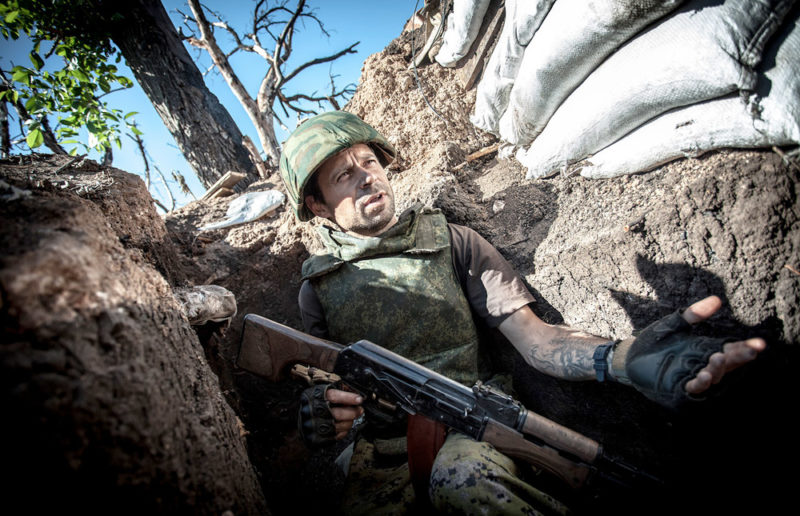
There are foreigners fighting on both sides, here a volunteer from Hungary in a first line position near Avdeyevka, DPR, august 2017. Photo: Sergey Belous / Free West Media
The OSCE Mission started on the 21st of March 2014, and Alexander Hug was part of it from the very beginning.
– The Mission was meant to monitor the situation after the Maidan events in February 2014 and, of course, then the demonstrations here in the east started. There were first protests in the streets, then buildings were occupied, the occupants started to arm themselves and within a very short time the Mission found itself confronted with an armed conflict that lasts to this date.
As the conflict evolved, also the Mission had to adapt its methods and equipment.
– We had no armed vehicles, for instance, our staff was not enough in numbers – we had, may be, 80 staff in total. We had to quickly find the appropriate staff to monitor an armed conflict. So you needed experienced colleagues. We had to completely change our training, we had to buy new equipment, protective equipment. And we had to change the way of how we operate. And all that during an ongoing situation, so we had no time to prepare. We have today a number of permanent presences dotted along this almost 500 kilometre contact line on both sides, like here in Donetsk or in Debaltsevo, Horlivka, the other side in Svetlodarsk, for instance, just opposite Debaltsevo.
Being at the front line, Hug meets a lot of civilians affected and sees tragedies and injustices. Many are very frustrated, since they have been under shelling for more than three years now in some of these towns: in Horlivka, in Avdeyevka, in the western part of the Donetsk city nonstop, he explains.
– There has not been a night when there was no firing. They are very frustrated, and they unload their frustration on the monitors. And it is not easy to take this. But we also see that there are moments that motivate us where we see that people are either thankful for our work, because they know we can make a difference, or because we see, and that is also personal for me, that these people here on both sides are incredibly resilient, they are not giving up even though their houses have been destroyed, they have no more work, no more money, lost their relatives, their house burnt down – they are still not giving up. It’s very impressive to see that. And that keeps my motivation high and also that of my colleagues.
– I feel often, of course, that the civilians know even better than we what needs to be done. Because they see tanks in the Trudovsky area [neighbourhood of Donetsk, very close to the contact line] next to their house. They know that when they fire, it will only take a few seconds before there will be a counter fire coming in. They know what needs to happen: these tanks need to disappear. The civilians have lived this conflict, they are the experts and they know also that it is up to those who have signed on the dotted line [in the Minsk Agreement] to end it.
All rights reserved. You have permission to quote freely from the articles provided that the source (www.freewestmedia.com) is given. Photos may not be used without our consent.
Consider donating to support our work
Help us to produce more articles like this. FreeWestMedia is depending on donations from our readers to keep going. With your help, we expose the mainstream fake news agenda.
Keep your language polite. Readers from many different countries visit and contribute to Free West Media and we must therefore obey the rules in, for example, Germany. Illegal content will be deleted.
If you have been approved to post comments without preview from FWM, you are responsible for violations of any law. This means that FWM may be forced to cooperate with authorities in a possible crime investigation.
If your comments are subject to preview by FWM, please be patient. We continually review comments but depending on the time of day it can take up to several hours before your comment is reviewed.
We reserve the right to delete comments that are offensive, contain slander or foul language, or are irrelevant to the discussion.
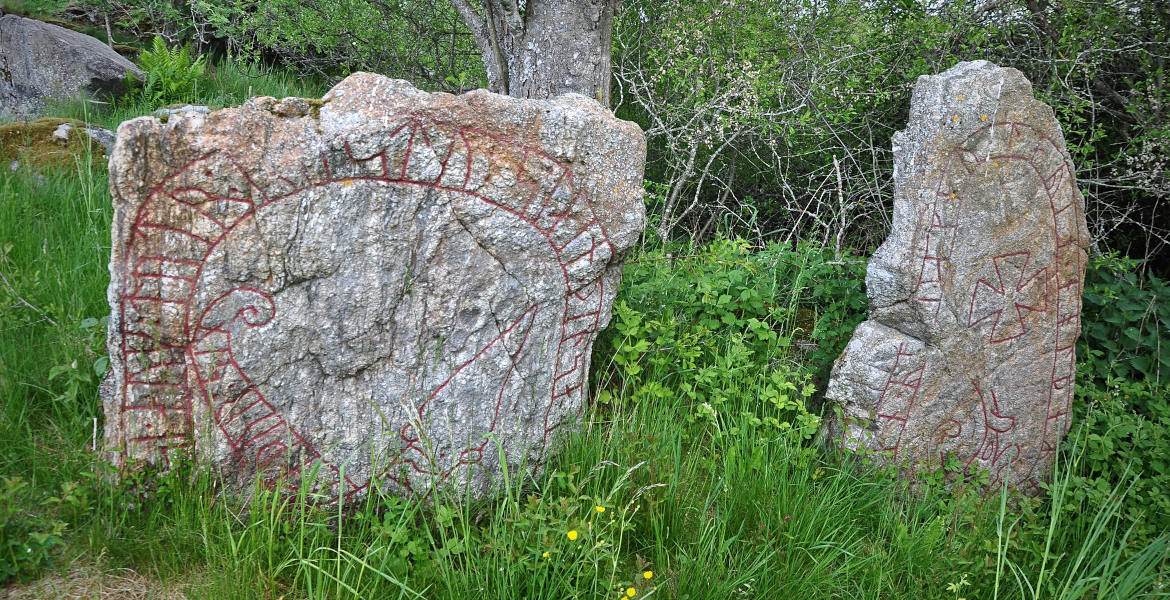
New App Helps Locate Sweden’s Historic Runestones
A new app called Swedish Runestones will help locate historical gems.
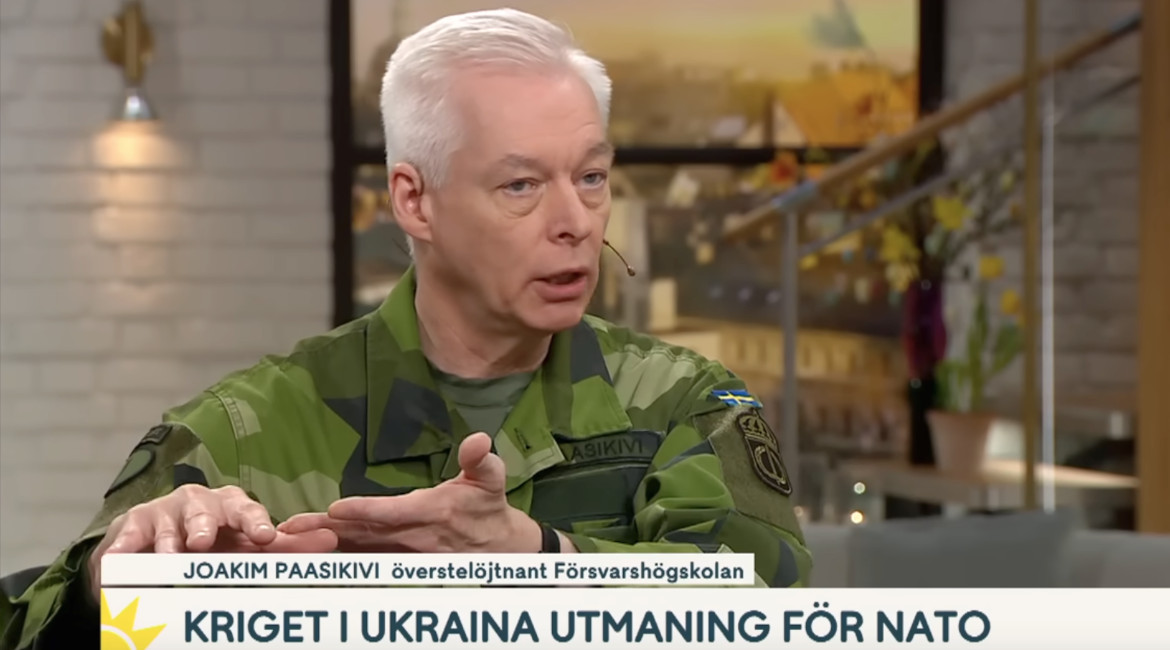
Swedish military wants to remilitarize the Åland Islands
The demilitarized autonomy has previously been known as 'the islands of peace.

NOAA Predicts Zero Sunspots for Almost the Whole 2030s
CLIMATEThe United States' government scientific organization, the National Oceanic and Atmospheric Administration (NOAA), predicts zero sunspots from 2031 to 2040. This is an extreme situation that has not occurred in as long as humanity has been counting sunspots, and it leads us into uncharted territory in terms of our solar system. However, this prediction aligns with the warnings of the world-renowned solar researcher Valentina Zharkova for many years, who indicated in 2019 various signs of this catastrophic phenomenon, including the extreme hailstorms we have seen in Europe and the world this summer. The forecast and various observations this year give cause for very significant concern. In this unique analysis, Free West Media explains why.
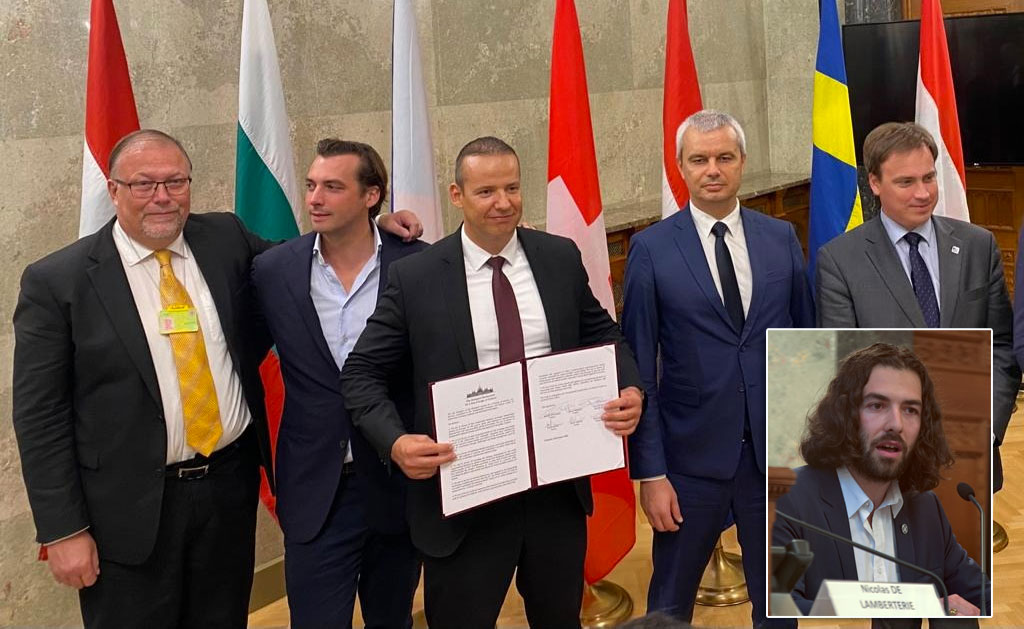
European Nationalist Parties Forge Cooperation Ahead of EU Elections
EUROPEAN ELECTIONSOn Saturday, August 26, representatives of six European nationalist parties gathered in Budapest. The meeting was initiated by the Hungarian party Mi Hazánk and took place in the national parliament. Representatives of the parties signed a joint declaration that not only reaffirms the parties' friendship but also their unity on a range of complex political issues. A surprisingly clear and radical manifesto was established. The hope is that this cooperation will lead to success in the EU elections and eventually result in the formation of a group in the European Parliament. For Swedish nationalism, this meeting marks a success as Sweden, for the first time, has a party represented in a leading nationalist cooperation in Europe. Free West Media was present at this historic event.
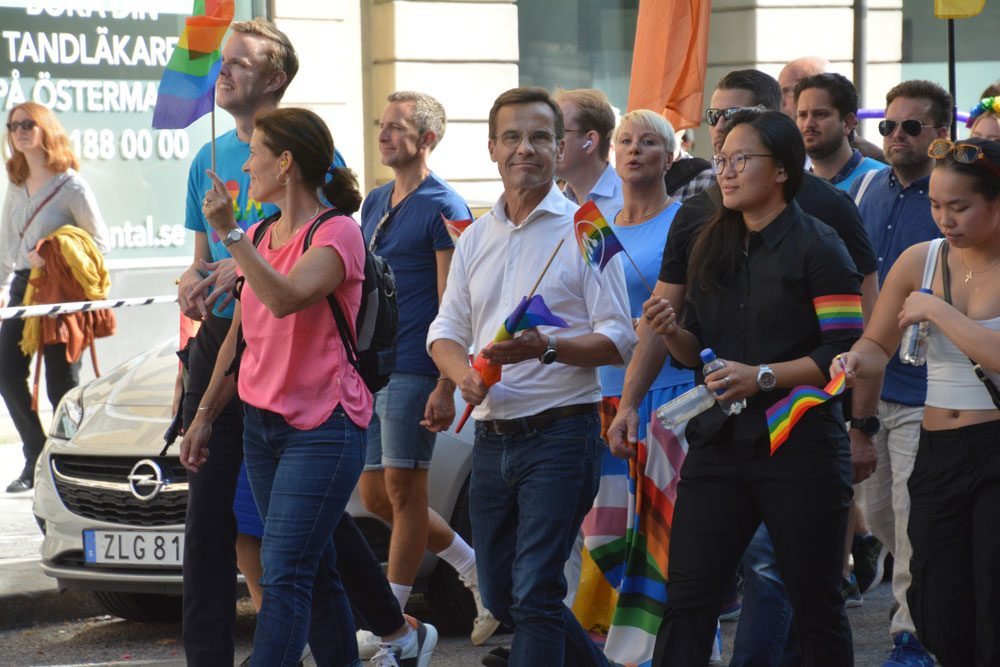
Turkey Believes Sweden Hasn’t Done Enough
Sweden will have to wait a bit longer for NATO membership, according to Turkey's Justice Minister Jilmaz Tunc. First, Sweden must extradite the "terrorists" Turkey wants and stop the desecration of the Quran.
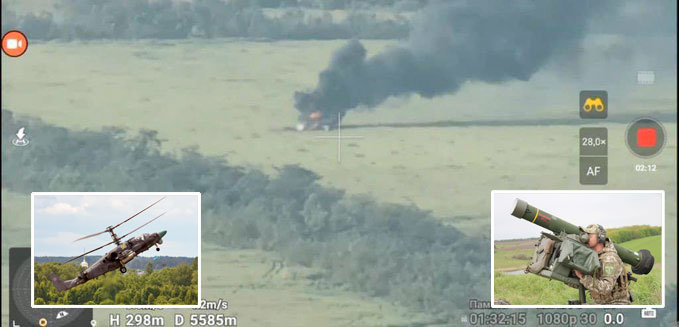
Swedish Weapon Takes Down Russia’s Best Attack Helicopter
The Russian attack helicopter Ka-52 is considered one of the world's best and has struck fear in Ukraine, where it has hunted down tanks and other armored vehicles, often beyond the range of many light anti-aircraft systems. However, it has met its match in the Swedish air defense missile system RBS 70, which has quickly led to significant losses for the Russian helicopter forces.
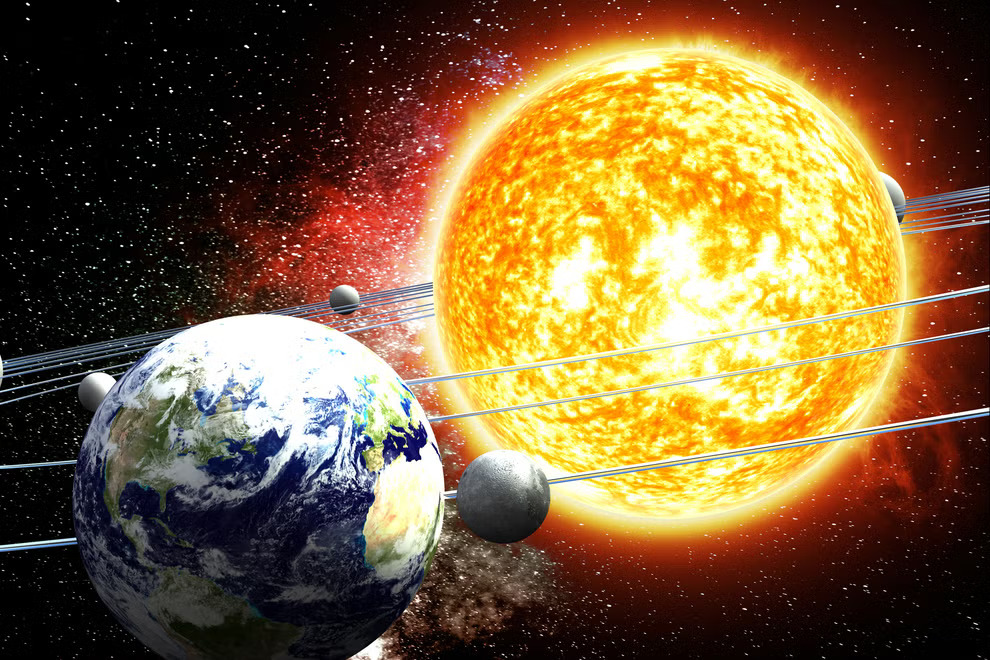
The Sun Drives Earth’s Climate, Not Carbon Dioxide
Top Researchers Push Back Against Climate Lies."The correlation is as clear as day," explained the Israeli astrophysicist Nir Shaviv, who was hailed by the establishment, before his interview with Forbes was hastily deleted. What he says contradicts the climate narrative, which points to humans as responsible for Earth's climate. Shaviv firmly asserts that it is the sun that controls the climate, something that can be scientifically proven in many ways. Contrary to the popular belief, the sun's influence on Earth has, in recent years, caused unusually cold and rainy weather, a trend that solar researchers warn will worsen significantly in the coming decades. The sun has exhibited an unusually low activity since 2016, during Solar Cycle 24, which was the weakest in a century.
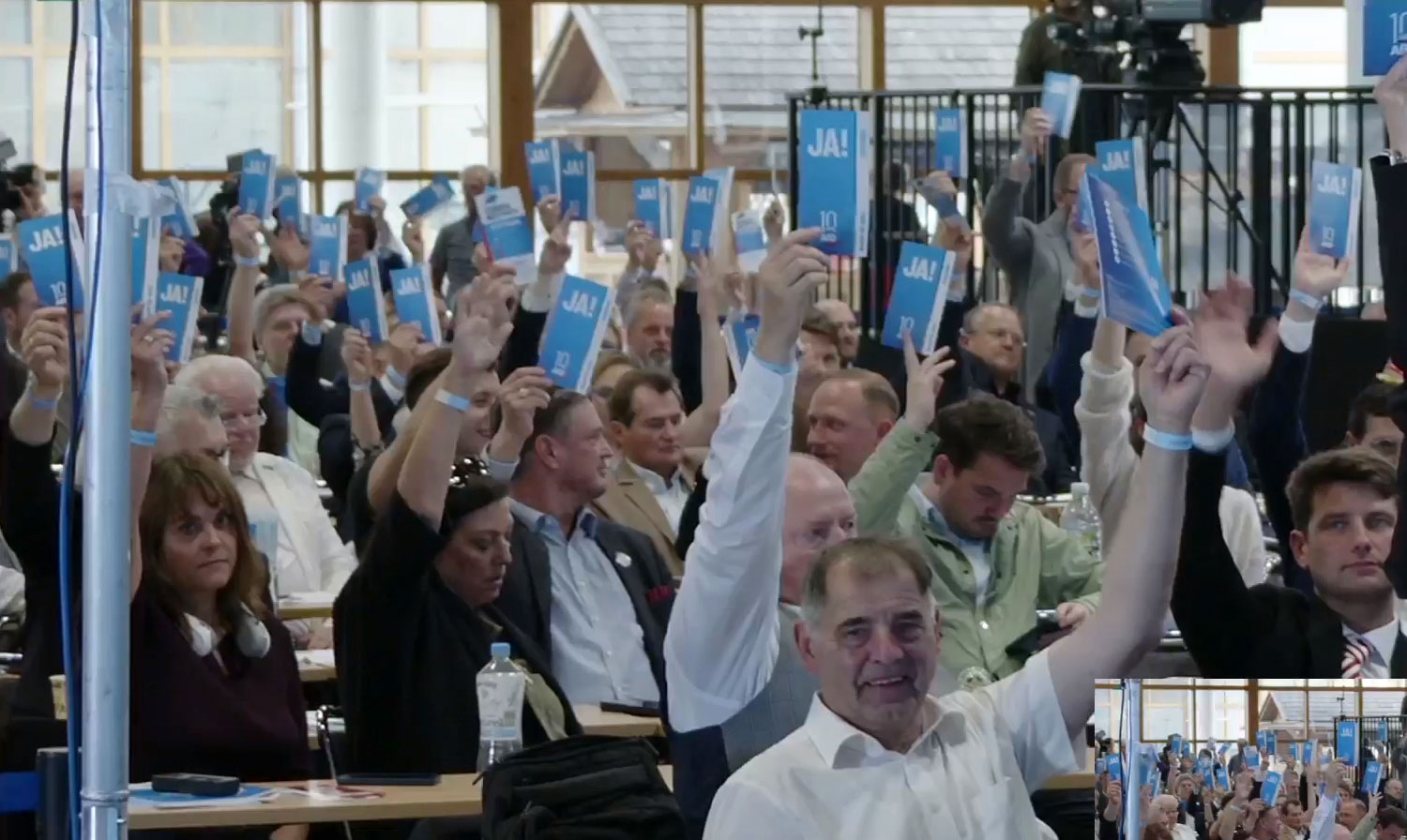
Strong Confidence in German AfD
Alternative for Germany (AfD) held a party conference on July 29-30 to select candidates for the upcoming EU election next year. EU Parliament member Maximilian Krah, belonging to the party's more radical, ethnonationalist faction, was appointed as the top candidate. The party's two spokespersons delivered powerful speeches criticizing the EU's failed migration policy and trade sanctions that isolate Europe and Germany from the rest of the world. They argued that it's time for the EU to return a significant portion of its power to national parliaments. However, they have dropped the demand for Germany to exit the EU.
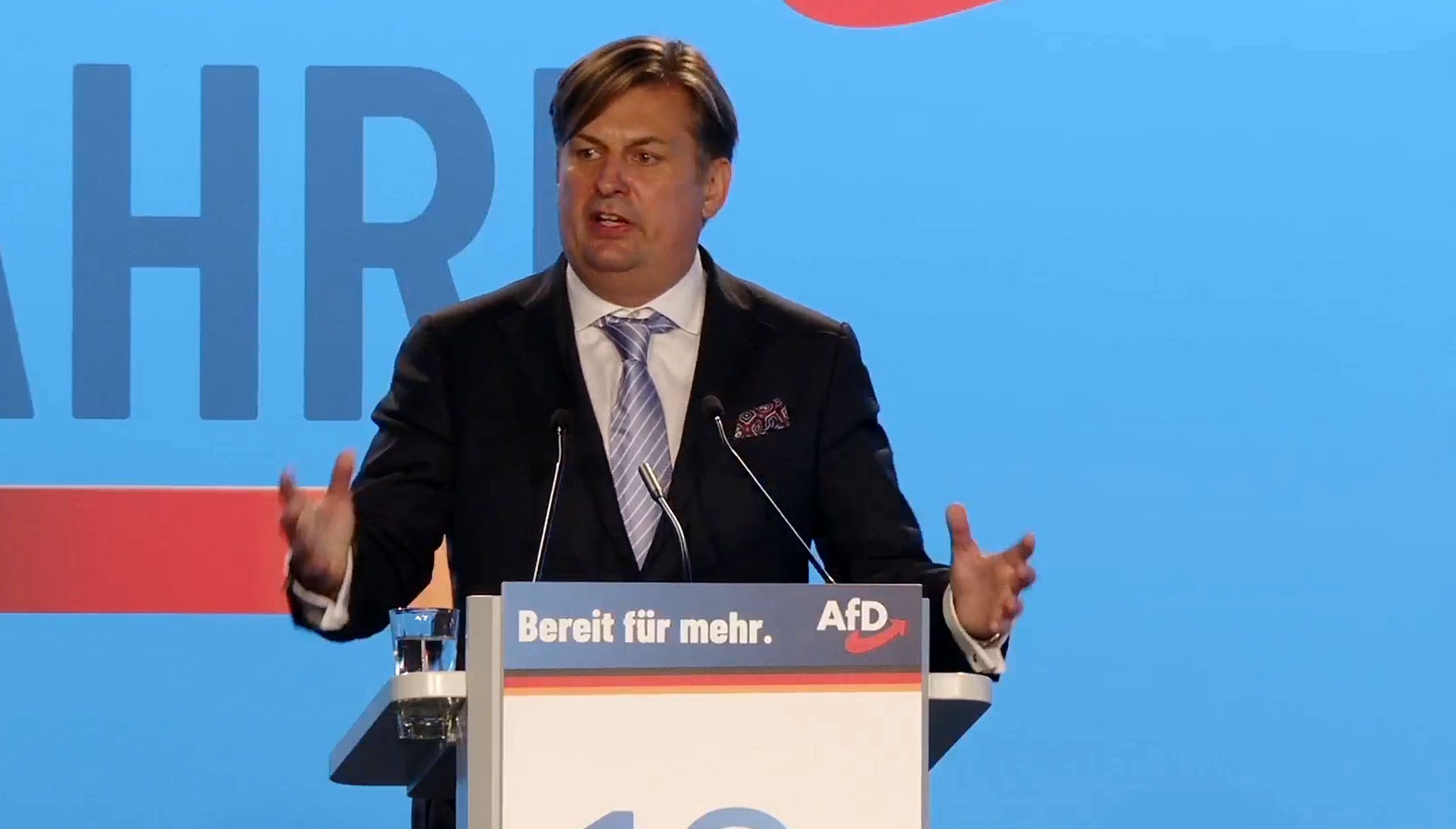
The Establishment Wants to Ban Germany’s Second Largest Party – for the Sake of Democracy
The rising popularity of AfD has raised strong concerns within the establishment. Despite lies and demonization in the media and isolation from the overall political establishment, the party continues to grow. Certain representatives of the party are accused of becoming increasingly "extreme," and in an unusual move, the influential weekly newspaper Der Spiegel demanded that AfD be "banned."

Dutch FvD break through the media blockade
What is happening in the Netherlands? It is often difficult to follow events in other countries, especially when distorted by system media. We give Forum for Democracy (FvD) the opportunity to speak out on the political situation in the Netherlands and the staunch resistance they face in trying to save the country.


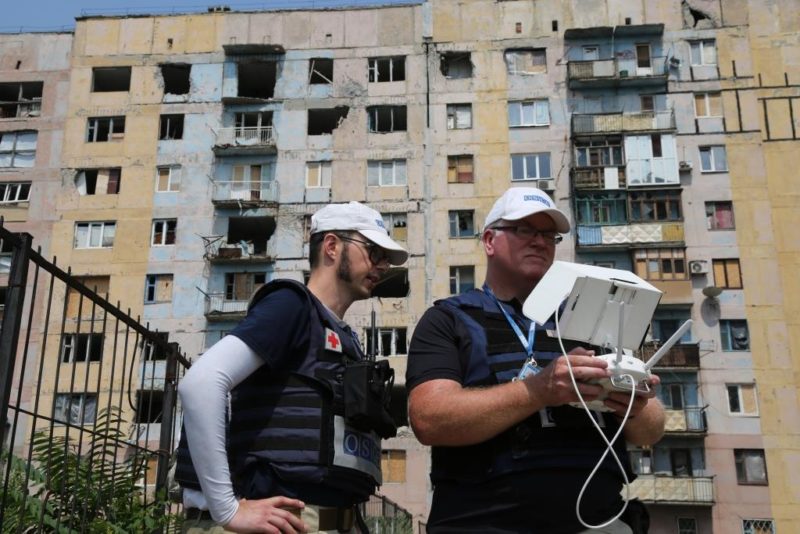
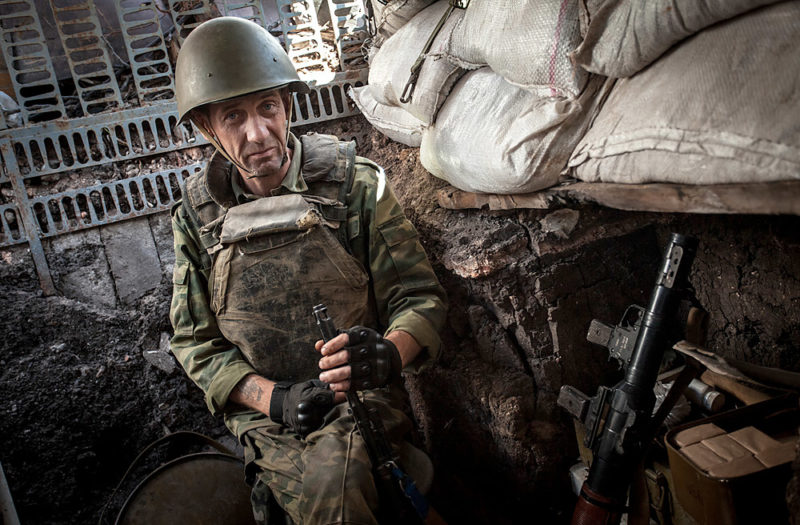


No comments.
By submitting a comment you grant Free West Media a perpetual license to reproduce your words and name/web site in attribution. Inappropriate and irrelevant comments will be removed at an admin’s discretion. Your email is used for verification purposes only, it will never be shared.